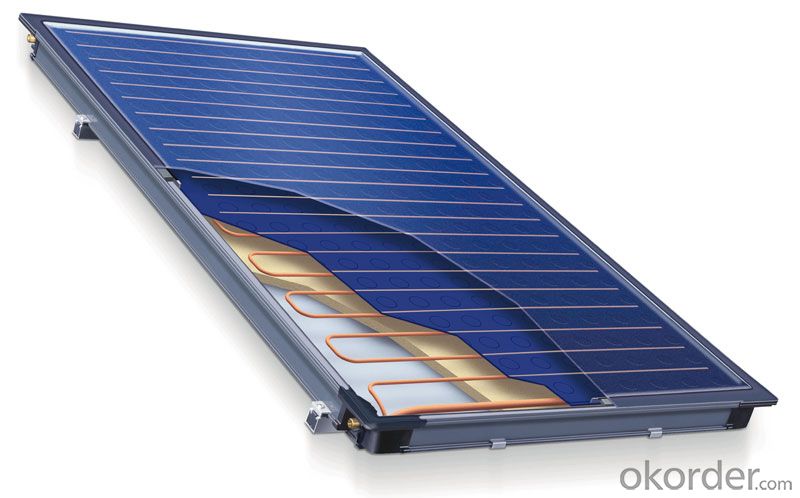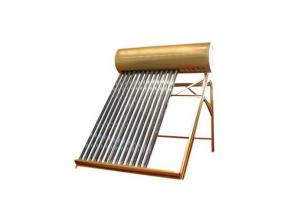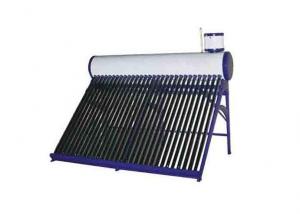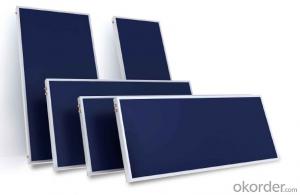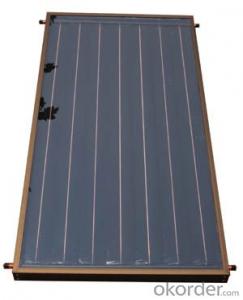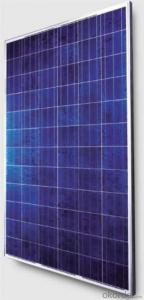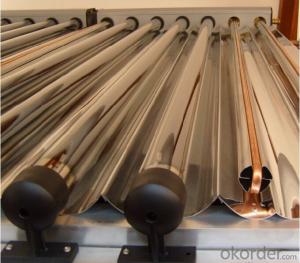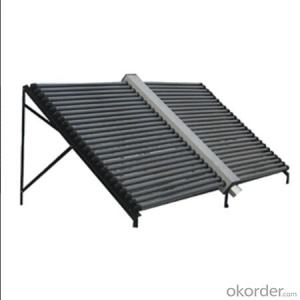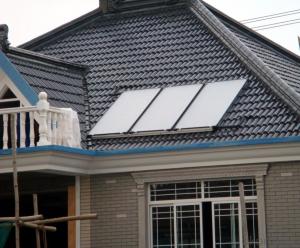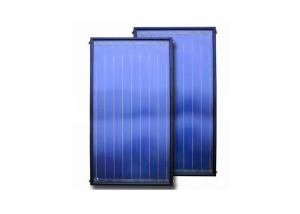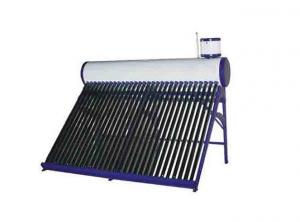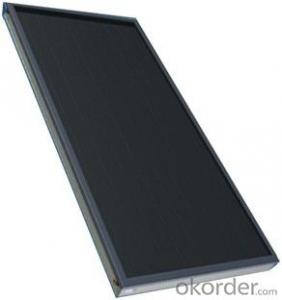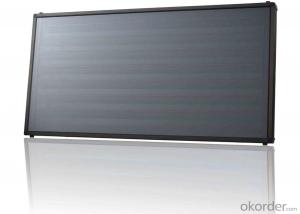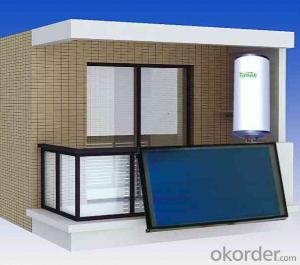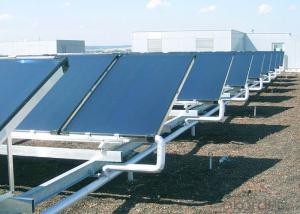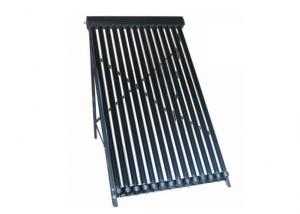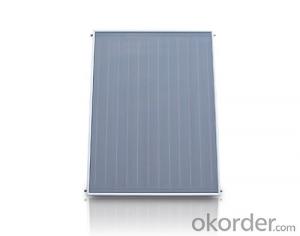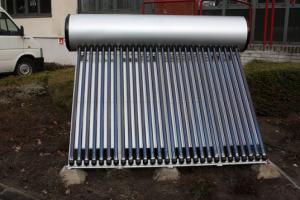PHNIX flat plate solar thermal collectors with Germany absorber
- Loading Port:
- Shanghai
- Payment Terms:
- TT OR LC
- Min Order Qty:
- 500 pc
- Supply Capability:
- 10000 pc/month
OKorder Service Pledge
OKorder Financial Service
You Might Also Like
Specifications
PHNIX flat plate solar thermal collectors with Germany absorber
1.ODM&OEM
2.Absorber:eta plus-Cu from Germany
3.Solar keymark
PHNIX flat plate solar thermal collectors with Germany absorber
It consists of
Flat-plate copper absorber of solar energy : Germany eta plus-Cu
Absorber coating : Highly selective vacuum coating
Heat transfer medium : Polypropylene glycol/water mixture
Insulating layer : Glass wool with great thermostability
Heat transfer medium tube : Copper tube
Outer casing : Aluminum alloy
How does flat plate solar thermal collectors work?
Sunlight passes through the glazing and strikes the absorber plate, which heats up, changing solar energy into heat energy. The heat is transferred to liquid passing through pipes attached to the absorber plate.
Absorber plates are commonly painted with "selective coatings," which absorb and retain heat better than ordinary black paint. Absorber plates are usually made of metal—typically copper or aluminum—because the metal is a good heat conductor. Copper is more expensive, but is a better conductor and less prone to corrosion than aluminum. And our flat plate solar thermal collectors are made of high performance copper absorber.
In locations with average available solar energy, flat plate collectors are sized approximately one-half- to one-square foot per gallon of one-day's hot water use.
Applications
The main use of this technology is in residential buildings where the demand for hot water has a large impact on energy bills. This generally means a situation with a large family, or a situation in which the hot water demand is excessive due to frequent laundry washing. Commercial applications include laundromats, car washes, military laundry facilities and eating establishments. The technology can also be used for space heating if the building is located off-grid or if utility power is subject to frequent outages. Solar water heating systems are most likely to be cost effective for facilities with water heating systems that are expensive to operate, or with operations such as laundries or kitchens that require large quantities of hot water.
Unglazed liquid collectors are commonly used to heat water for swimming pools. Because these collectors need not withstand high temperatures, they can use less expensive materials such as plastic or rubber. They also do not require freeze-proofing because swimming pools are generally used only in warm weather or can be drained easily during cold weather.
While solar collectors are most cost-effective in sunny, temperate areas, they can be cost effective virtually anywhere in the country so should be considered.

- Q: Can solar collectors be used in areas with high levels of dust or dirt?
- Yes, solar collectors can be used in areas with high levels of dust or dirt. However, it is important to regularly clean the collectors to maintain their efficiency. Additionally, using protective measures like tilt or rinse systems can help minimize the impact of dust or dirt on the performance of solar collectors.
- Q: Can solar collectors be used for heating sports facilities?
- Yes, solar collectors can be used for heating sports facilities. Solar thermal systems can capture sunlight and convert it into usable heat energy, which can then be used to warm indoor spaces like sports facilities. This renewable energy source is environmentally friendly and can help reduce dependence on traditional heating methods, making it a sustainable option for heating sports facilities.
- Q: Can solar collectors be used for heating restaurants and food service establishments?
- Yes, solar collectors can be used for heating restaurants and food service establishments. Solar thermal systems can efficiently capture and convert sunlight into heat energy, which can then be used for various heating applications, including space heating, water heating, and even heating for cooking processes in commercial kitchens. By utilizing solar collectors, restaurants and food service establishments can significantly reduce their reliance on traditional fossil fuel-based heating systems, leading to cost savings and a more sustainable operation.
- Q: What is the working principle of flat solar collectors?
- Flat plate solar collector heat plate is flat shape, hence the name. It consists of transparent cover, heat sink, and jacket composed of four parts. The solar radiation passes through the transparent cover of the collector, is projected on the heat absorbing plate, the heat absorbing plate absorbs and converts it into heat energy, and then the heat is transferred to the heat transfer medium in the heat absorbing plate to raise the temperature Useful energy output.
- Q: Are solar collectors suitable for heating office buildings?
- Yes, solar collectors are suitable for heating office buildings. They can effectively capture solar energy and convert it into heat, providing a renewable and environmentally friendly source of heating. Additionally, solar collectors are cost-effective in the long run as they can reduce energy bills. However, the suitability may depend on factors such as building design, location, and energy requirements, which should be assessed before implementation.
- Q: Are solar collectors suitable for hotels and resorts?
- Yes, solar collectors are suitable for hotels and resorts. Solar collectors, also known as solar thermal systems, use panels to collect and absorb sunlight, converting it into heat energy. This heat can then be used for various purposes such as heating water for showers, pools, and space heating. Hotels and resorts have high energy demands due to the continuous need for hot water, air conditioning, and heating. Solar collectors can significantly reduce their dependence on traditional fossil fuel-based energy sources, leading to substantial cost savings and environmental benefits. Installing solar collectors in hotels and resorts can also enhance their sustainability credentials, attracting eco-conscious guests who prioritize environmentally friendly accommodation options. This can improve the hotel or resort's reputation and help differentiate it from competitors. Furthermore, solar collectors can be integrated into the architectural design of hotels and resorts without compromising their aesthetics. They can be installed on rooftops, facades, or in the vicinity of the property, maximizing the utilization of available space. In summary, solar collectors are a highly suitable and beneficial energy solution for hotels and resorts. They help reduce energy costs, enhance sustainability, and attract environmentally conscious guests. By harnessing the power of the sun, hotels and resorts can contribute to a greener future while maintaining their high standards of comfort and service.
- Q: Can solar collectors be used for refrigeration?
- Yes, solar collectors can be used for refrigeration. Solar thermal energy can be harnessed and converted into cooling power using absorption refrigeration systems. These systems use solar collectors to heat a working fluid, which then drives a refrigeration cycle to produce cold temperatures for cooling purposes. This sustainable and efficient technology is especially beneficial in areas with abundant sunlight and high cooling demands.
- Q: Can solar collectors be used for heating cathedrals?
- Yes, solar collectors can be used for heating cathedrals. Solar thermal collectors can capture sunlight and convert it into heat energy, which can then be used for heating purposes. This renewable energy source can be an efficient and sustainable option for heating large spaces such as cathedrals.
- Q: Can solar collectors be used for heating museums and cultural centers?
- Yes, solar collectors can be used for heating museums and cultural centers. Solar thermal systems can capture the sun's energy and convert it into heat, which can then be used for space heating or water heating purposes in these buildings. This renewable energy source can provide a sustainable and cost-effective solution for heating while reducing greenhouse gas emissions. Additionally, solar collectors can be integrated into the architecture of these buildings without compromising their aesthetic value.
- Q: How do solar collectors perform in humid climates?
- Solar collectors can still perform effectively in humid climates. Although increased humidity can affect the overall efficiency of solar collectors, they are specifically designed to withstand and function optimally in various weather conditions, including humidity. Proper maintenance and regular cleaning of the collectors are essential to ensure their optimal performance in humid environments.
Send your message to us
PHNIX flat plate solar thermal collectors with Germany absorber
- Loading Port:
- Shanghai
- Payment Terms:
- TT OR LC
- Min Order Qty:
- 500 pc
- Supply Capability:
- 10000 pc/month
OKorder Service Pledge
OKorder Financial Service
Similar products
Hot products
Hot Searches
Related keywords


